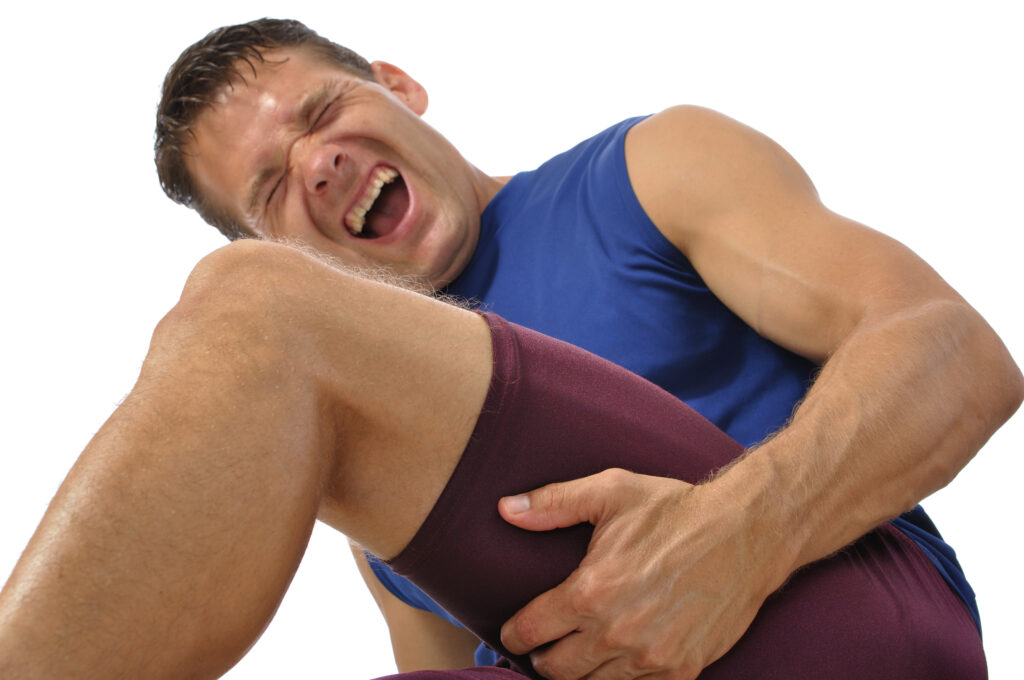Everyday exercisers, weekend warriors and sportsmen often suffer injury due to a few common mistakes that can be prevented with careful attention. Injuries are an unfortunate risk that comes with playing sports. After an athlete suffers an injury, many times they don’t treat the injury properly which causes a delayed or incomplete recovery and more time on the sidelines. This can be due to the athlete simply not knowing what to do, ignoring the injury, or getting bad medical advice/treatment. Here’s what to be aware of so you can move and exercise without joint pain or injury.
High Intensity: Doing too much, too soon
When starting a new exercise program, motivation is typically high. It’s easy to get caught up and decide that while a 30-minute workout is good, a 2-hour workout is even better. Before you know it, you’ve got nagging joint pain and have to stop your workout routine completely. Joint pain and injury is common when you don’t allow the body to adapt slowly to exercise. Remember it’s not just your heart and lungs that need to slowly work up to harder or longer workouts; every system in your body needs time to adapt: your circulatory system, respiratory system, muscles, ligaments, cartilage and even your bones and joints. It’s important to ease into exercise, regardless of how motivated you are to do more–even if it feels “OK” at the time. Start with lighter activity, shorter durations, and less frequent workouts (to allow for some recovery days) and then progress as you feel up to it–but no more than about 10% per week.

Improper Exercise Selection: Doing too many high-impact exercises
Joint injury can occur more easily during high-impact activities. It’s a common belief that high-impact means “hard” and low-impact means “easy,” but these actually describe the intensity of your body striking the ground. If one or both of your feet is off the ground, even for a split second (such as when you run or jump), the exercise is high-impact, meaning your body has to absorb a higher impact of shock when you come in contact with the ground. Because high-impact exercises put more stress on the joints and skeletal system, they actually help strengthen bones, reducing the risk of osteoporosis. However, the higher the impact, the greater the injury potential. Assuming you have a doctor’s clearance and take good care of your body, you can still perform high-impact activities safely when you take certain precautions (like using proper form). But more importantly, aiming for a variety of impact levels in your workouts is ideal. Too much high-impact is, well, too much for the joints. If you are looking for activities that are easier on the joints, there are a number of options available. Swimming, water exercise and biking are all no-impact cardiovascular workouts. Some low-impact options include walking, biking and the elliptical. Just because an activity doesn’t involve lots of running and jumping doesn’t mean it can’t be a great workout. As long as the activity is challenging and gets your heart rate up into the cardio zone, you’ll be on your way to losing weight and improving your fitness level.
Doing Repetitive Movements: Performing the same activities all the time
It’s important to find activities you enjoy, because that makes it easier to stick with an exercise routine. But you can end up with too much of a good thing if you are always doing the same activity all the time. For example, you like running so you do it every day as your only form of exercise. Taxing the same muscles (and joints) in the same way day after day can easily lead to overuse injury and wearing down of cartilage. This is one reason why performing a variety of activities each week is important. By moving your muscles and joints in different directions and intensities, you can help prevent injury.

Poor Biomechanics: Exercising with improper technique
Whether riding a stationary bike or lifting weights, proper technique is essential to preventing joint injury. For example, if the seat of the bike isn’t positioned properly, it can put extra pressure on the knee that wouldn’t otherwise occur, increasing the risk of injury. If you try a new weight machine at the gym without knowing how to use it, this increases your risk of injury. If you don’t have ideal gait patterns or alignment (and most people don’t), you are putting your joints at risk with every step, lunge, jump and squat–unless you know how to correct yourself. The truth is, few people without formal instruction know how to line up every joint and move through the correct range of motion that keeps their joints safe. While it’s something anyone can learn, it takes diligence and attention during every movement–not just in the beginning, but forever. If you aren’t sure how to do an exercise properly ask a qualified fitness trainer to help. You could also hire a personal trainer for a short time to learn these basics, or even go to a group fitness class where a qualified instructor will be able to explain and point out those keys so that all participants stay safe.
Using Faulty Fitness Equipment
With the growing popularity of health and wellness, more people are attempting to live a healthier lifestyle by increasing their level of exercise. With that, a lot more exercise equipment is being used at home or at a gym. While many people may exercise for years without suffering any injuries resulting from equipment use, in fact, thousands of people sustain injuries every day while using fitness and gym equipment. Improper use, faulty equipment, and poorly maintained equipment can lead to a wide range of different injuries.

Skipping the warm up, cool down or stretches
When you’re short on time, it’s tempting to skip one (or more) of these pieces of the workout routine. But there is an important reason for each one, and choosing not to do them can lead to joint injury. A proper warm up safely prepares the body for the increased demands of exercise by generating heat, increasing circulation to the muscles and joints, and lubricating the joints for activity. Cold muscles do not absorb shock or impact as well, and are more susceptible to injury, so always warm up for at least a few minutes before you work out. The cool down brings your heart rate back to normal slowly and safely, which helps prevent pooling of the blood in the extremities (which can cause dizziness or fainting), and stretching after a workout (when the muscles are warmer, lubricated and more elastic) helps maintain and increase joint mobility.
Wearing the wrong footwear
When heading into a specialty shoe store for the first time, it’s easy to get sticker shock. Typically there are lots of options, many of which can be expensive. Although you might save money by picking up some shoes on sale at your local discount store, you may also be increasing your risk of injury by wearing shoes that don’t meet your needs. It is important to analyze your foot, gait and foot strike, and look for any mechanical or anatomical issues to determine the right shoe for you. Athletic shoes are designed for specific purposes. Running shoes often provide some motion control and cushioning for forward motion, but won’t have the ankle support you’d need for playing basketball, which involves a lot of lateral movement and sudden directional changes. An investment in good footwear for your specific activity can prevent injury and pain, as well as the expense from doctor’s visits and physical therapy.

Recovery: Skimping on rest
Most people think that exercise itself is what leads you to be stronger and fitter, but it’s actually the rest that happens after a workout that creates those positive changes in your body. When it comes to getting results and protecting your joints, rest is just as important as exercising with good form. You aren’t being lazy by taking rest days–you’re being smart. Taking days off from exercise helps prevent overuse injuries, stress fractures, and joint inflammation that can lead to pain. Recovery is the time your body uses to adapt to the stresses you’ve put on it, as well as repair tissues that were damaged during your workouts. If you avoid rest days and don’t give your muscles and joints a chance to recover, you’ll continue to break the body down instead of making it stronger. A good rule of thumb is to allow for 1-2 rest days per week. This doesn’t mean you have to sit on the couch all day and do nothing. It’s OK to do some light activity, like go for a walk or do an easy yoga session. But your activity shouldn’t be intense or challenging. Your body–and your joints–need the time to rest and repair.
Inadequate Nutrition
When muscles become excessively damaged, it triggers inflammatory hormones that favor the destruction of the tissue and the resistance to produce new tissue. These inflammatory responses depend on the total muscle mass and they can be influenced by nutrition. This is why the metabolic profile, nutritional profile and the body composition of an athlete can influence muscle recovery when there is an injury. From a nutrition perspective, it is important to consider the potential of nutrition to assist in injury prevention and prevent the loss of lean mass during immobilization, and to consider the change in energy requirements during the injury period along with any strategies that may promote muscle repair. Exercise related fatigue, which is characterized by an inability to continue exercise at the desired pace or intensity, is just one example. Nutritional causes of fatigue in athletes include inadequate total energy intake, glycogen depletion, dehydration, and poor iron status.
Prevention of dehydration and muscle glycogen depletion necessitates maximizing muscle glycogen stores prior to and during exercise, as well as beginning activity euhydrated (normal state of body water content). Following a proper hydration schedule also helps maintain that hydration status. For female athletes there is yet more to consider. Research shows there is a positive relationship among injury, disordered eating, menstrual dysfunction, and low bone mineral density. A recent update on stress factors in female athletes suggests that early screening for the female athlete triad and other nutrition strategies be part of the preventative strategies against the overuse injury.
It’s easy to assume that older adults or those with previous injuries are most at risk for joint problems. But the fact is, anyone can experience joint pain or injury if they aren’t careful. If you are new to exercise, or if you have had joint problems in the past, it’s always a good idea to talk to your doctor or work with a qualified personal trainer before you start an exercise plan. These professionals can give you personalized advice based on your medical history and offer tips to help you have a safer workout. While there is some inherent risk in any type of exercise, the benefits of working out regularly far outweigh the risks for most people. With attention to the prevention and safety tips above, you’ll be strengthening and protecting your joints for the rest of your life by exercising your body regularly.

Dr Saranjeet Singh
Fitness & Sports Medicine Specialist
Lucknow








A great help to understand silly mistakes, most of us make while training.
Thanks Neeraj.
GREAT article sir !
Certainly following these precautions with your perfect guidance works MAGIC , I’ve experienced it !
Thank you Saurabh.